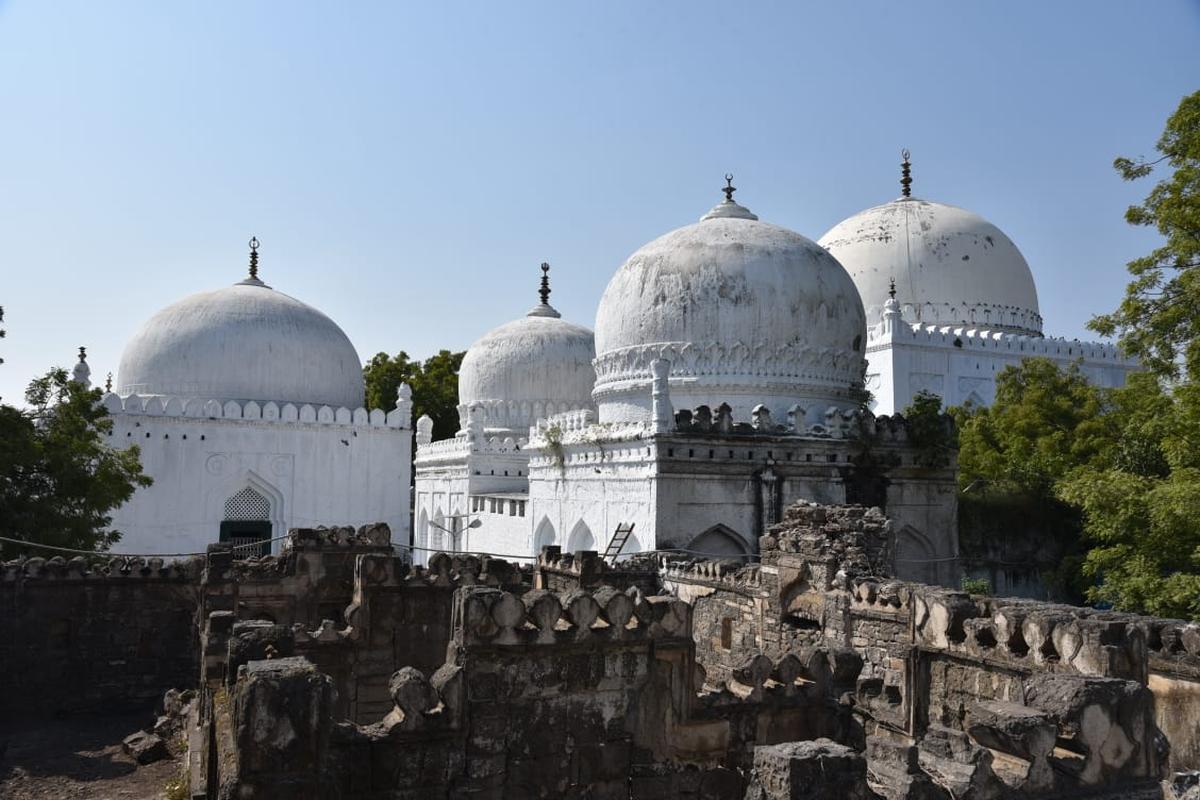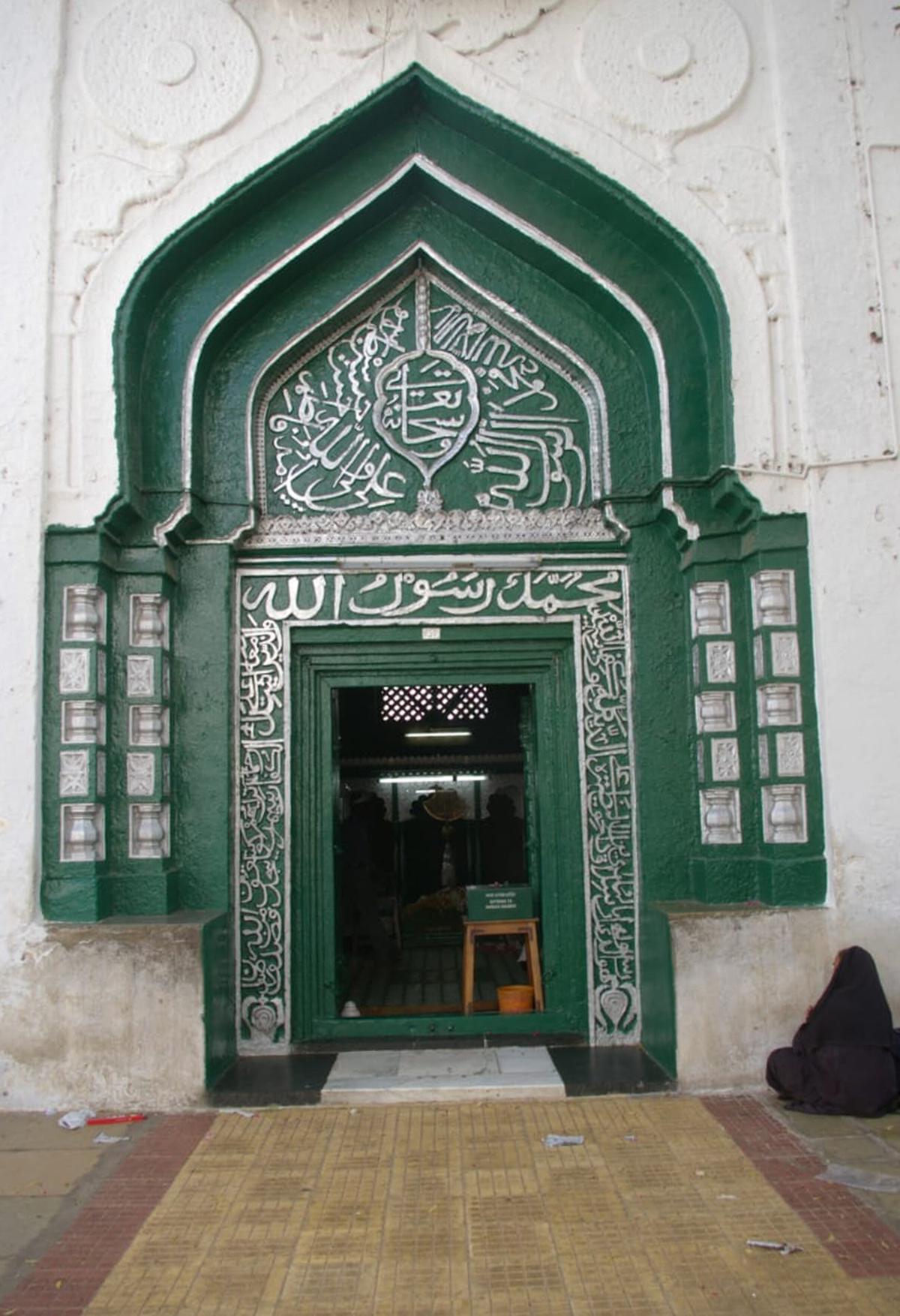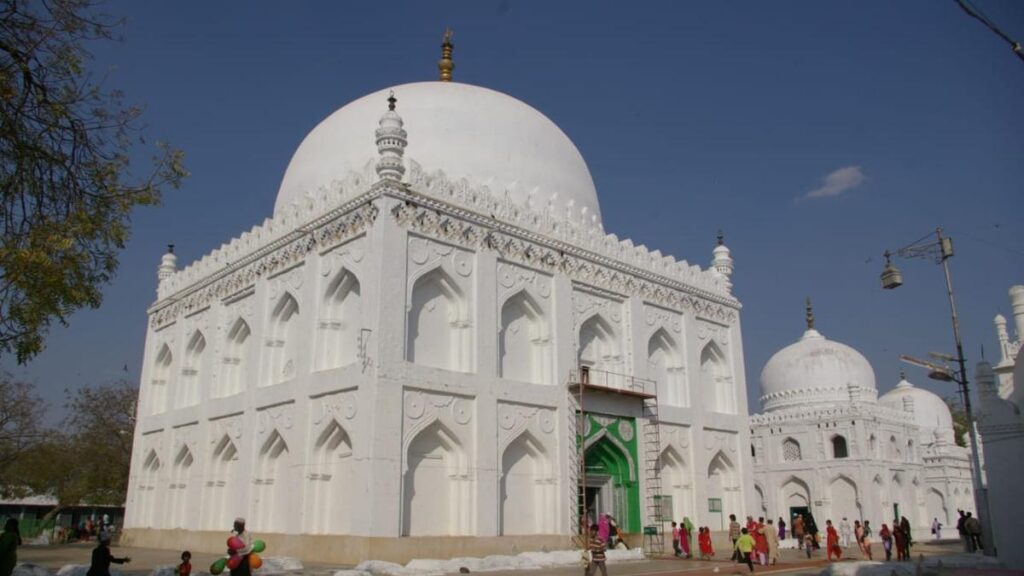Two revered saints of the Chishti order — Hazrath Khwaja Moinuddin Chishti and Hazrath Khwaja Banda Nawaz Gesu Daraaz — spread Sufism in India, one in the north and the other in the south, respectively.
It was at the fag end of 14th Century that Bahmani ruler Firuz Shah invited Banda Nawaz to his capital Kalaburagi and requested to settle down here. For 22 years, the Sufi saint was engaged in a wide range of religious activities here, often blending mainstream Islamic practices with those of spiritual practices, to the people across Kalaburagi and the Deccan region. The Sufi saint passed away on November 1, 1422.
Today his resting place in Kalaburagi is not just a relic of the past, but a shrine of peace and reverence. Besides spreading Sufism, his greatest contribution was the introduction of the Dakhani language in the Deccan, which later became Dakhni Urdu.

Old structures with the dargah complex
| Photo Credit:
SPECIAL ARRANGEMENT
Birth and migration
The Sufi Saint Mohammad Gesu Daraaz, also known as Hazrath Khwaja Banda Nawaz, was a disciple of Hazrath Nasiruddin Chirag Dehlavi in Delhi, who eventually took over as his successor.
His patronymic name was Abul-fatah and Gesu Daraz was the title given to him by his mentor. Among the scholars and theologians he was Shaikh Abul-Fatah Sadr Uddin Muhammad Dehlavi but popularly he was known as Khwaja Banda Nawaz Gesu Daraz.
Banda Nawaz was born to Syed Walshareef Muhamad bin Yousuf Al Husaini in Delhi on July 13, 1321. Though he spent his childhood days in Delhi, his family was forced to migrate to Daulatabad following the then Sultan of Delhi Muhammad Bin Tughlaq’s decision of changing his capital from Delhi to Daulatabad. Banda Nawaz lost his father when he was 10. After knowing about Shaikh Nizamuddin Auliya from various Sufis, his eagerness of becoming his disciple brought him back to Delhi.

Main entrance to the mausoleum.
| Photo Credit:
SPECIAL AARANGEMENT
But Auliya had already left and his place was occupied by his successor Shaikh Nasiruddin Chirag Dehlavi, of whom Banda Nawaz became disciple in 1336.
After 20 years, in 1356 Shaikh Nasiruddin Chirag Dehlavi bestowed on Banda Nawaz the permission to maintain his own circle of disciples and passed away the same year. Banda Nawaz took charge of his preceptor’s monastery and stayed at Delhi for the next 44 years teaching at the Khanqah – where he carried out the act of Da’wah- religious discourses.
Before the Timur invaded Delhi Sultanate in 1398, the 80-year-old Banda Nawaz along with his family and few disciples, embarked on a journey to Daulatabad again, where he paid homage to his father’s grave and intended to settle down there. On knowing of his arrival to Daulatabad, the Bahmani ruler Firuz Shah invited him to Kalaburagi. Since then, his name is firmly associated with Kalaburagi.
Courtyard and gigantic arch gate towards the south of the dargah.
| Photo Credit:
Arun Kulkarni
Literary contributions
The Sufi Saint significantly contributed to the world of poetry and Islamic literature. He authored several books on Sufism and other subjects in Arabic, Persian, and Urdu. His writings, particularly his poetry, convey the core philosophy of Islam and mysticism.
The library of the dargah in Kalaburagi is a repository of rare collections on books, manuscripts, farmaans, holy Quranic inscriptions and literary works of Khwaja Banda Nawaz. Collection includes Tasawwuf (Sufism), Fiqh (Islamic jurisprudence) and Ilm-e-Kalam (discourse).
The history of Sufis and a commentary of the holy Quran titled Tafsir-e-Multaqit, written by Banda Nawaz, in Arabic language, however the library has got only its photocopy and the original copy of which were in London Library and Kutubkhana Asifia in Lucknow.
The library of the dargah in Kalaburagi.
| Photo Credit:
Arun Kulkarni
The library also preserves rare collections of other great Sufis such as the original volume of Awariful Maarif, the famous Persian treatise on Sufism written by 12 th century Sufi Shahab al-Din Abu Hafs Umar al-Suhrawardi. Tafseer-e-Azeezi – a translation and commentary on the holy Quran, written on silk pages by 18 th century scholar Shah Abdul Aziz, is another treasure by the library. Though the calligraphy was done 200 years ago, the text retains the original texture. The Urdu translation runs underneath every line of the Arabic text. The Quran sharif weighs 20 kg consisting of 1,151 pages
An imperial firmaan (Decree) written in 1578, by Hasan Shah Wali (former Sajjada nasheen of Banda Nawaz) in Khat-E Shikasta, in Persian language; and the writings of the firmaan run in the pattern of a sword. The collection has also got Shajra (Genealogy) from Prophet Adam to Prophet Muhammad, inscripted on the cloth.
This historic library is visited by research scholars from American and British universities. To preserve these literary treasures for future generations and make them accessible online to benefit researchers, scholars and the common public, the former Sajjada Nasheen Dr. Syed Shah Khusro Hussain and the present Sajjada Nasheen Syed Shah Muhammad Ali Al-Hussain took a proactive role in digitizing manuscripts and restoration and rebinding of the old books.
(From left) A Shijra (Genealogy) of Prophet Mohammed and Farmaan, a decree written by Hasan Shah Wali ( former Sajjan Nasheen of Hazrath Khwaja Banda Nawaz)
| Photo Credit:
Arun Kulkarni
Architectural features
The grandeur of the historical dargah with a mausoleum of a 14th century Sufi saint beckons every visitor to step into a world where history and devotion intertwine.
The interior was subjected to renovation in the 90s with mirror work that obscured the original Deccani motifs. Certain details such as the five-faceted mihrab, the fluted trefoil squinches, the sprawling dome designs, and arches echo the Indo-Islamic and Persian style of architecture creating a unique blend with the Quranic inscriptions and litany of holy names. The very entrance of the mausoleum features intricate geometric and floral designs, a hallmark of the Indo-Saracenic architectural style. The mausoleum of the Banda Nawaz built by the then Bahmani rulers Firuz Shah and Ahmed Shah, is said to be the largest among all the Sufi saints’ tombs, explains Mohammad Ismail, a numismatist and researcher who extensively studied Bahmani architecture.
Researchers Ismail and Mohammad Ayazuddin Patel narrate the historical background of each tomb and the structures scattered within and around the main tomb in the shrine. Another marvelous monumental structure in black stones in dargah premises is said to have been built for Chand Bibi, wife of Ali Adil Shah I. However, she was not buried here and the monument is called as Khali gumbad.
Towards south, facing the Khaja Banda, Nawaz’s tomb is the old main entrance gate of the dargah, which remains closed now. The grandiose arch is framed by two square towers with openings on four levels and overhanging balconies. A gallery over this arch is decorated with leaf-shaped merlons. The Spandrels of arch and roundels depicting elephants carrying lions, below the arch a small chamber with a curved vaulted roof structure at the centre recalls the Mughal architectural elements. This ceremonial arch opens to a courtyard consisting of rooms for pilgrims, a small mosque and a library-with overhanging balconies on brackets are assigned to the Adil Shahi period, claims the researchers.
The Khanqah –a Sufi’s abode located to the southeast of the court yard was a residence of Banda Nawaz , where he lived for 22 years conducting spiritual activities.
A place for spiritual discourse, inside the dargah, where Hazrath Khwaja Banda Nawaz stayed for 22 years, carrying religious discourses and spreading Sufism.
| Photo Credit:
Arun Kulkarni
Preserving the legacy
The present Sajjada Nasheen Syed Shah Muhammad Ali Al-Hussaini has continued the legacy with enthusiasm.
Sajjada Nasheen’s grandfather Padmasri Hazrath Syed Shah Muhammad Al Hussaini Saheb was instrumental in establishing schools and colleges for Girls under Khaja Education Society in 1958, which was a pioneering step towards women empowerment and set a precedent for girl’s education in the community. The Philanthropist has built a veritable educational empire, having 24 institutions.
In 2007, former Sajjada Nasheen Dr Syed Shah Khusro Hussaini succeeded him. He established Khaja Banda Nawaz University (KBNU) in 2018 bringing all the higher educational institutions run by Khaja Education Society under one umbrella. Today the University has thousands of scholars’ and graduates every year. Now, the present Sajjada Nasheen Syed Shah Muhammad Ali Al Hussaini has continued this tradition.
Annual Urs
The annual Urs-e-Sharief (death anniversary) of Banda Nawaz is observed on 15,16,17 Dhu al-Qadah (11th month of Islamic calendar) with the flag hoisting ceremony (Parcham Kushai) marking its beginning. The Sajjada Nasheen of Dargah performs the traditional ritual and ceremonial observances during three-days. Devotees cutting across religious boundaries participate in the Sandal procession followed by the fortnight long Urs.
The city transforms into vibrant, festive space during this period, streets get decorated with lights. Qawwali maestros from across the country throng at the dargah during the Urs and perform at Sufi shrine to honor saint and engage in devotional practice.
Published – May 23, 2025 09:00 am IST
Source:https://www.thehindu.com/news/national/karnataka/kalaburagi-cherishes-the-enduring-legacy-of-banda-nawaz/article69605080.ece

